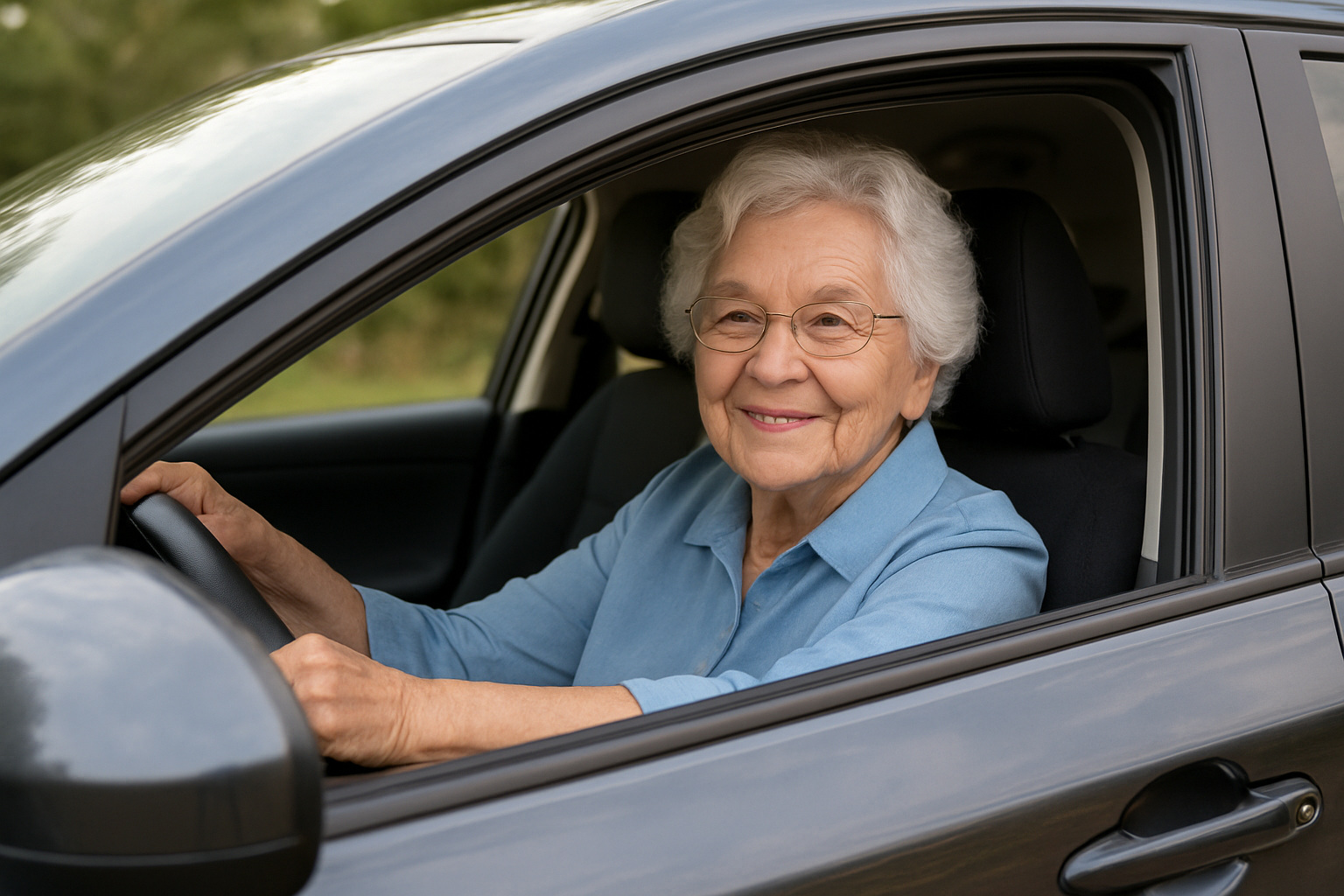

Aging Behind the Wheel: How Attention and Behaviour Shape Road Safety Outcomes
Australia's population is ageing because of increased life expectancy and decreasing fertility rates [1]. The number and proportion of older Australians is expected to continue increasing. The Australian Bureau of Statistics (ABS) projects that by 2071, the elderly would increase from 17% in 2022 to between 25% and 27% of the overall population [2]. While older drivers (65+) are involved in relatively few crashes, the outcomes are often more severe. When fatal crashes do occur, the majority involved are older drivers, accounting for 50.5% of deaths in this age group over the decade. Between 2014 and 2024, total annual road fatalities in Australia rose by 85, representing a 7% increase. For drivers aged 65 and over, the increase was proportionally higher, with 38 additional deaths over the decade, constituting a 14.1% rise. The fatality rate among people aged 75 years and over remains the second highest of all age groups, accounting for 44% of deaths. However, it has declined by 22.0% over the reporting period, reaching 7.6 deaths per 100,000 people in 2024 [3].

Elderly Drivers and Accident Patterns
Older drivers usually adopt a more cautious driving style and engage in fewer illegal or risky behaviours compared with other age groups. They often manage their exposure to potential hazards by avoiding nighttime driving or peak traffic periods [4]. However, several factors can increase the risk of accidents for older drivers, including:
1. Functional limitations
2. Physical fragility
3. Driving exposure and experience
For example, older drivers face a higher risk of serious accidents at intersections, particularly right-angle collisions. Intersections require quick processing of multiple sources of information, which becomes increasingly difficult with age due to declines in attention, reaction time, vision, cognition, and physical ability [4] [5]. According to Transport for NSW data, the leading reason for licence cancellations, disqualifications, or suspensions is medical administration action [6]. Together, these factors highlight the importance of understanding age-related changes and implementing strategies to help older drivers stay safe on the road.
Timely reminders in everyday environments can reinforce positive behaviours. Research shows that Australians aged 70 to 80 shop twice a week or more, creating regular, high-attention moments in trusted community spaces[7]. With a network of over 320 shopping centres nationwide, Convenience Advertising provides a powerful opportunity to connect with older Australians during their everyday routines, reinforcing safer driving behaviours through consistent, contextually relevant messaging.
Other Risk Behaviours to Watch
With 1,361 road deaths recorded across Australia in the 12 months to October 2025, it’s clear that age is only one part of the road safety picture[8]. Risky behaviours including speeding, drink and drug driving, distraction, and seatbelt non-use continue to play a significant role in fatal and serious crashes.
• Speeding – Speed remains the leading contributor to serious collisions. For example, 63% of Victorian drivers admitted intentionally driving 3 km/h or more over the limit [9].
• Distraction – Drivers texting, browsing or using a mobile phone are up to 10 times more likely to crash [10] ; 52 % of drivers reported mobile phone use while driving [9]. Mobile phone detection cameras recorded 6,421 infractions between January 1, 2025, and March 31, 2025 [11].
• Impaired driving – Around one in five drivers killed on Victorian roads had a blood alcohol concentration of .05 or higher [12] ; 41 % of drivers and motorcyclists killed had drugs in their system [13] ; Driving while tired contributes to 16-20% of all road crashes in Victoria [14].
• Seatbelt and Restraints – Driving without properly fastened seatbelts is causing people to be killed or gravely injured on our roads. Seatbelt detection cameras recorded 7,466 drivers and 5,176 passengers not wearing seatbelts between January 1, 2025, and March 31, 2025 [11]. In addition, there is an increase in injuries among children over the age of seven who were transitioned to adult seatbelts too soon [15].
While these statistics highlight the ongoing risks on the roads, they also reinforce a crucial truth that awareness alone isn’t enough. Preventing fatalities and injuries requires consistent,targeted communication that reaches people in the moments when their choices matter most. This is where strategic, attention-led messaging plays a vital role in shaping safer behaviours and driving real-world impact.
Reaching Drivers at Critical Moments
Convenience Advertising reaches Australians at crucial decision-making moments, with a network of more than 3,200 venues nationwide, including over 2,000 licensed pubs, clubs, and bars, environments where choices about driving are often made.
For the past 10 years, we’ve partnered with Transport for NSW, and for six years with the Transport Accident Commission (TAC) in Victoria, to deliver impactful road safety campaigns. Our network has also supported government-led initiatives across Queensland, Tasmania, South Australia, Western Australia, and the Northern Territory.

Turning Attention into Action
Behaviour change relies not just on awareness, but on capturing the right moment with the right message. With an average dwell time of two minutes in bathroom environments, our media ensures that messages are not just seen but truly absorbed. By aligning communication with everyday habits and decision points, Convenience Advertising transforms attention into meaningful, measurable action on road safety.
Understanding the aCPM Model
It’s a relatively new but powerful metric, combining the traditional cost per thousand (CPM) with attention per thousand (APM) to calculate attentive cost per thousand (aCPM). Unlike CPM, which only measures how many people see an ad, aCPM measures the cost of reaching people who are actually paying attention [16].
In high-attention environments like Convenience Advertising’s bathroom network, where the average dwell time is around two minutes, the aCPM model captures the true value of audience engagement. These are environments where people are stationary, unhurried, and free from distractions, meaning messages are not only seen but genuinely absorbed. While other out-of-home formats may appear cost-effective by CPM alone, bathroom media delivers far greater value per attentive second. This means every dollar spent translates into deeper engagement and stronger potential for behaviour change, especially when the message is safety-critical, such as drink or drug driving prevention.
Results That Matter
We’ve successfully delivered programs targeting the locus of risk in licensed venues, capturing more than 700,000 impressions per campaign. Through integrated CAQR™ codes, audiences can instantly access detailed program information that reinforces safer decision-making before they get behind the wheel. Each program has generated hundreds of scans,demonstrating strong engagement and behavioural relevance.
By combining high-attention environments, measurable audience engagement, and behaviourally timed messaging, Convenience Advertising provides a powerful platform for road safety communication. When campaigns reach people at the exact moment decisions are made, awareness becomes action that saves lives.
References
[1] Australian Institute of Health and Welfare. (2024, July 2). Older Australians. Retrieved November 10, 2025, from https://www.aihw.gov.au/reports/older-people/older-australians/contents/demographic-profile
[2] Australian Bureau of Statistics. (2023, November 23). Population projections, Australia. Retrieved November 10, 2025, from https://www.abs.gov.au/statistics/people/population/population-projections-australia/latest-release#assumptions
[3] Department of Infrastructure, Transport, Regional Development, Communications, Sport and the Arts. (2025, October 2). Road safety of older people. National Road Safety Data Hub. https://datahub.roadsafety.gov.au/safe-systems/safe-road-use/road-safety-older-people
[4] Government of South Australia. (n.d.). SOUTH AUSTRALIA’S ROAD SAFETY STRATEGY TO 2031. https://dit.sa.gov.au/__data/assets/pdf_file/0007/963187/SA_Road_Safety_Strategy_to_2031.pdf
[5] Salazar-Frías, D. et al. (2025) 'Do older drivers (65+) exhibit significant impairments in hazard prediction and attentional processes?,' Accident Analysis & Prevention, 222. https://doi.org/10.1016/j.aap.2025.108182.
[6] Transport for NSW. (2025, November). Licences and sanctions snapshot report. Retrieved November 10, 2025, from https://www.transport.nsw.gov.au/data-and-research/drives-reporting-portal/licences-and-sanctions-snapshot-report
[7] Australian Human Rights Commission. (2014). Older consumer fact sheet. https://humanrights.gov.au/sites/default/files/Older%20Consumers%20Fact%20Sheet.docx
[8] Bureau of Infrastructure and Transport Research Economics. (2025, September). Australian Road Deaths Database. Retrieved November 10, 2025, from https://app.powerbi.com/view?r=eyJrIjoiN2M1NjI0ZDQtZDhhYS00MDM5LTk5YzUtZmUwZjQ1M2JhYTgxIiwidCI6ImFhMjFiNjQwLWJhYzItNDU2ZC04NTA1LWYyY2MwN2Y1MTc4NCJ9
[9] Transport Accident Commission. (2025a). Road Safety Monitor 2024 Report FINAL. https://www.tac.vic.gov.au/road-safety/statistics/about-tac-surveys/road-safety-and-marketing-surveys/RSM-2024.pdf
[10] Transport Accident Commission. (n.d.). The facts - distractions and driving. Retrieved November 10, 2025, from https://www.tac.vic.gov.au/road-safety/staying-safe/distracted-driving/the-facts-distractions-and-driving
[11] Government of Victoria. (2025, August 22). Mobile phone and seatbelt detection cameras. Retrieved November 10, 2025, from https://www.vic.gov.au/mobile-phone-and-seatbelt-detection-cameras
[12] Transport Accident Commission. (2023, December 4). Drink driving. Retrieved November 10, 2025, from https://www.tac.vic.gov.au/road-safety/staying-safe/drink-driving
[13] Transport Accident Commission. (2025b). Drug driving. Retrieved November 10, 2025, from https://www.tac.vic.gov.au/road-safety/staying-safe/drug-driving
[14] Transport Accident Commission. (2024, May 19). Tired driving. Retrieved November 10, 2025, from https://www.tac.vic.gov.au/road-safety/staying-safe/tired-driving?tab=1
[15] Transport Accident Commission. (2025c). Seatbelts. Retrieved November 10, 2025, from https://www.tac.vic.gov.au/road-safety/staying-safe/seatbelts
[16] Follett, M. (2021, January). The true cost of advertising attention. WARC. https://www.warc.com/content/paywall/article/warc-exclusive/the-true-cost-of-advertising-attention/en-gb/135300
More insights:
 How CA have reshaped the power of attention, accountability, and data in public health messaging. With projects like DonateLife and metrics like aCPM, Peter highlights why Bathroom Advertising is stronger than ever.Read more
How CA have reshaped the power of attention, accountability, and data in public health messaging. With projects like DonateLife and metrics like aCPM, Peter highlights why Bathroom Advertising is stronger than ever.Read more
How data, seasonality and context influence more effective suicide prevention communication
Suicide risk peaks in warmer months and is higher in men, young women, and remote areas. Targeted messaging with QR codes provides discreet access to support when it’s most needed.Read more
Capturing attention in moments that matter most
Most ads go unseen or ignored, wasting millions in media spend. Convenience Advertising captures attention where others fail, delivering longer exposure, higher recall, and stronger engagement through distraction-free bathroom environments.Read more
